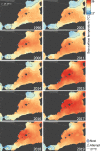New colonisers drive the increase of the emerging loggerhead turtle nesting in Western Mediterranean
- PMID: 38233518
- PMCID: PMC10794258
- DOI: 10.1038/s41598-024-51664-w
New colonisers drive the increase of the emerging loggerhead turtle nesting in Western Mediterranean
Abstract
The loggerhead sea turtle (Caretta caretta) is sensitive to climate change and is responding by colonising the Western Mediterranean. To understand the rapid nesting increase in recent years in Spain, we sampled 45 hatchlings from 8 nests between 2016 and 2019. We sequenced a mtDNA D-loop region, genotyped 2291 SNPs using 2bRAD and collected data on clutch size, hatching success, and incubation duration. We confirmed that the colonisation has a Mediterranean and Atlantic mixed origin and we detected that these nests were laid by different females, except for two nests within the same season. Our results suggest that the recent increase in nesting is due to an increase in the number of colonising individuals rather than females born in the same area returning to breed. We hypothesize that this increase in the number of colonisers results from successful conservation efforts, feminisation of the populations of origin and earlier sexual maturation. However, the percentage of offspring females produced in Spain suggests that future returning individuals will aid to the settlement of the new population. These results allow defining the current status of this colonisation although future efforts are needed to detect remigrants to confirm the establishment of a resident population.
© 2024. The Author(s).
Conflict of interest statement
The authors declare no competing interests.
Figures





References
-
- Pörtner, H. O. et al. IPCC, 2022: Summary for policymakers (2022).
-
- Langan JA, Puggioni G, Oviatt CA, Henderson ME, Collie JS. Climate alters the migration phenology of coastal marine species. Mar. Ecol. Prog. Ser. 2021;660:1–18. doi: 10.3354/meps13612. - DOI
MeSH terms
Substances
LinkOut - more resources
Full Text Sources

